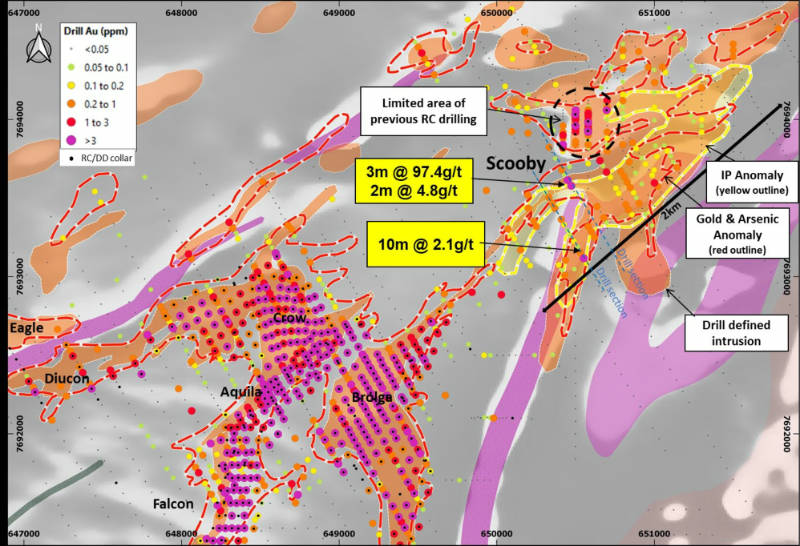You might be interested in
Mining
All the richest people in the world are stockpiling gold. These ASX stocks are racing to supply it
Mining
Gold Digger: Gold vs Bitcoin, analysts vs analysts – store of value narratives get in the ring
Mining
Mining
Special Report: De Grey has identified widespread gold mineralisation at the Scooby and Antwerp targets where aircore drilling returned significant results.
Results such as 1m at 264 grams per tonne gold from a depth of 45m within a broader 3m interval at 97.4g/t gold at the Scooby target don’t grow on trees and while other intersections were broader with more modest gold grades, it still bodes well for the future.
The drilling has now defined a 2km by 1km gold-arsenic zone at Scooby with a coincident induced polarisation target and a similarly-sized zone at Antwerp.
De Grey Mining (ASX:DEG) technical director Andy Beckwith says the identification of widespread gold mineralisation at the two targets warrants follow-up reverse circulation (RC) drilling.
“This drilling will commence in the near future in parallel with resource delineation and extension drilling at Hemi, including at the recently discovered Diucon and Eagle zones,” he added.
“The new IP target coincident with gold and arsenic mineralisation at Scooby are encouraging.
“The IP results potentially provide a new tool to identify and prioritise targets beneath the transported cover. Diucon, Eagle and Antwerp will be our next priority IP areas.”

Aircore and RC drilling at Diucon and Eagle had intersected encouraging alteration and gold mineralisation.
Drilling at the Alectroenas target has highlighted elevated zones at the northern and southern margins of the intrusion with a top result of 12m at 0.5g/t gold while historical and recent infill aircore has defined a semi continuous zone of anomalous gold-arsenic mineralisation along the northern margin of the intrusion at the Shaggy prospect.
Aircore drilling at Scooby was completed to an average depth of between 50m to 60m due to the hardness of bedrock and aircore rig penetration.
While the shallow penetration provides information on only a relatively thin veneer of the underlying intrusion, areas where deeper aircore drilling has been achieved have returned broad, lower-grade intercepts such as 48m at 0.2g/t gold that suggests that wider zones of mineralisation and alteration occur.
Previous limited RC drilling in the northern portion of anomalous gold-arsenic mineralisation and north of the main IP anomaly also returned results such as 14m at 3.5g/g gold from 37m and 15m at 0.7g/t from 38m.
De Grey plans to kick off RC drilling at Scooby that targets the higher grade gold mineralisation within the IP target. This will test to a depth of about 200m.
At Antwerp, the aircore drilling has highlighted a series of gold-arsenic intersections distributed throughout the Antwerp intrusion complex with results such as 23m at 0.6gt gold from 52m demonstrating the potential for a broadly mineralised system.
Drilling has shown that the depth of cover reduces significantly to about 5m in the western portion of the prospect area.
Interestingly, the recent gold mineralisation defined at Eagle has the potential to link up with zones within Antwerp.
Step-out RC drilling will test this potential.
This article was developed in collaboration with De Grey Mining, a Stockhead advertiser at the time of publishing.
This article does not constitute financial product advice. You should consider obtaining independent advice before making any financial decisions.